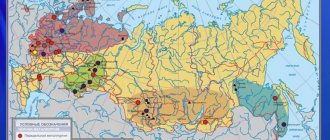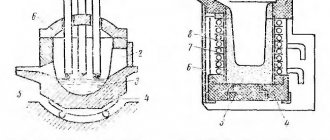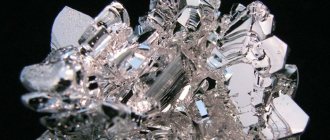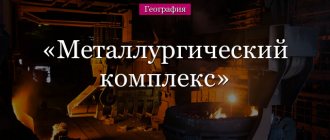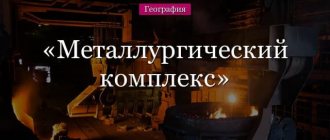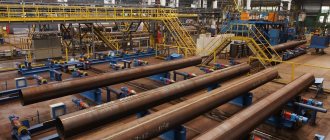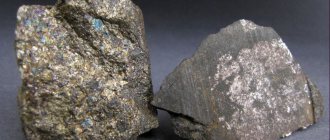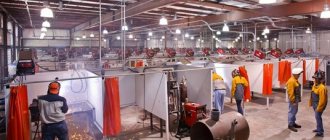Non-ferrous metallurgy is an industry that includes the extraction, enrichment and creation of alloys from non-ferrous metals. Its condition is decisive for the development and functioning of the entire industrial complex as a whole.
Non-ferrous metals should be understood as substances and alloys that do not contain iron. This is the main difference between the industry in question and ferrous metallurgy, which is based on the extraction of iron ore and the production of cast iron and steel.
Classification of non-ferrous metals
In modern industry, there are several groups of non-ferrous metals, which differ in their performance properties and qualities. Let's look at some of them:
- Heavy. Includes nickel, zinc, lead, copper. They have high density and weight.
- Lungs. First of all, it is aluminum, which has low density and, as a result, low weight. In addition, this group includes magnesium, titanium, and lithium.
- Small ones. Includes cobalt, mercury, antimony, arsenic, bismuth. Used in various industries. Due to the fact that the deposits are adjacent to deposits of heavy metals, they are mined as a by-product.
- Alloying (or refractory). These are vanadium, tungsten, chromium, molybdenum. They have a high degree of wear resistance. Their industrial application is in the smelting of alloys to improve the performance properties of finished products.
- Noble ones. This group includes gold, platinum, and silver. They are extremely rare and have a high degree of resistance to oxidation, so their use is not limited only to jewelry. Also included in this type are osmium, iridium, ruthenium, and palladium.
- Rare earths. These are scandium, thulium, lutetium, europium, etc. Application is limited, since the deposits are small and located on different continents, which greatly complicates production.
Where are they used?
Imagine a world without non-ferrous metals. Throw away your phone and computer, along with your car keys. Turn off the light - because current flows through wires made of non-ferrous metal. You will also have to throw away the gas and electric stoves, and cook over a fire or build a stove. Therefore, let us treat these different and so necessary metals with respect.
It is impossible to imagine the modern world without the use of non-ferrous metals.
Some of them are mined in millions of tons per year, others several tons per year. But all of them are absolutely necessary for modern industry and for us, consumers.
Electrical engineering, steel alloying, sensors, diodes, thermocouples, infrared optics, military-industrial complex.
Sub-sectors
Non-ferrous metallurgy includes sub-sectors within which the production of various metals is carried out:
- Aluminum production.
It accounts for more than 45% of the smelting volume of all non-ferrous metals. The raw material is bauxite, which is processed into alumina. The main deposits are located in Australia, Brazil, equatorial Africa, China and Russia.
The leading aluminum producers in the world are Russia, the USA, Italy, China, and Germany.
- Copper production.
More than a quarter of the total smelting volume is copper. It is mined from copper ore, where the metal concentration can reach about 30-35%. In addition, the processing of secondary raw materials plays a significant role.
The main deposits of copper ore are located in Russia, Kazakhstan, Chile, the USA, Canada, equatorial Africa, and China.
The leading producers are Russia, China, the USA, and European countries.
- Lead and zinc production.
These metals are produced from polymetallic ores. The main deposits are located in the USA, Mexico, Canada, China, and Australia. Production is concentrated in China, USA, Japan, Australia, and EU countries. The smelting of zinc and lead accounts for more than 22% of the total volume.
- Nickel production.
The largest deposits are located in Russia, which is also the world's main producer. The production of this metal accounts for less than 7% of global smelting. The main raw materials are nickel ores.
- Tin production.
This metal is obtained from tin ores. Most of the world's reserves are in Bolivia and Southeast Asia. The leading smelting centers are Bolivia, Malaysia, China, and Russia.
The production of other non-ferrous metals is less developed and has a local scale.
Recycled raw materials
It is already clear that non-ferrous metal production does not always meet the needs of industry. You have to dodge. That is, organize recycling collection points and collect scrap metal for delivery at these points. By the way, they pay quite well for scrap non-ferrous metals.
The cost of metal waste is formed based on several components:
- Metal (type, rarity).
- Dimensions.
- Batch size.
- The purity of the metal, its quality.
Scrap metal hunters
Copper, aluminum, lead, and titanium are in great demand among receivers.
- Copper contains copper alloys (brass).
- Tin is much more expensive than copper, especially in its pure form, but also in the form of utensils and babbitt (in bearings, for example).
- Nickel is an expensive metal, but it is rarely found in its pure form. In nickel silver dishes, used electrodes, heating elements of household appliances.
- Lead is sold “in the form” of batteries, printing equipment, and cable braids.
- Aluminum is inexpensive.
- pure zinc ; it is sold in the form of alloys.
- The most expensive metals are molybdenum and tungsten.
Stages of the production process
Non-ferrous metallurgy involves a number of production processes, including both the extraction of raw materials and smelting.
Schemes for the production of non-ferrous metals, although generally similar, however, due to the characteristics of a particular resource, have some differences.
In this regard, as an example, we should mention the aluminum production cycle, the production of which has the greatest scale and significance.
It consists of the following steps:
- bauxite mining;
- beneficiation of aluminum ore (washing, screening);
- alumina production;
- smelting of metal material;
- production of aluminum billets and semi-finished products.
Fluoride salts and electrodes are also produced from alumina.
Industry specifics
Non-ferrous metal ores, as mentioned above, contain a small amount of the mined element. Therefore, for a ton of the same copper, up to 100 tons of ore are needed. Due to the large demand for raw materials, non-ferrous metallurgy is, for the most part, located close to its raw material base.
Non-ferrous ores require large amounts of fuel or electricity for their processing. Energy costs reach half of the total costs associated with smelting 1 ton of metal. In this regard, metallurgical enterprises are located in close proximity to electricity producers.
The production of rare metals is mainly based on reduction from compounds. Raw materials come from intermediate stages of ore beneficiation. Due to the small volumes and difficulty of production, laboratories are engaged in obtaining rare metals.
General overview of the state of non-ferrous metallurgy in Russia
This branch of industrial production is one of the most developed in Russia. This is explained by large reserves of raw materials and natural resources, as well as a developed production base remaining after the collapse of the USSR.
History of industry development
Humanity began to smelt metal and use alloys quite a long time ago, which is confirmed by archaeological finds.
In Russia, the production of non-ferrous metals and the development of mining in general is largely associated with the name of Peter I. It was according to his decrees that the first smelting plants were built in the Urals.
By the beginning of the 20th century, the country became one of the world leaders in metallurgical production, but the events of 1917 stopped its development for a long time. However, in the 30s, during the first five-year plans, the country was able to restore and increase its industrial power.
After the Second World War, the largest mining and processing plants and metallurgical plants were built in the USSR, many of which continue to operate today. The crisis of the 90s had a negative impact on the state of this industry, but already in 2000, the production of non-ferrous metals in the country increased significantly.
Location of industrial production
Due to economic feasibility, most non-ferrous metallurgy enterprises are located in the area where the corresponding ores are mined. For this reason, there are several main production bases in Russia. It is worth noting that the smelting of light metals requires a large amount of energy; therefore, factories are built near its sources (mainly hydroelectric power stations).
Location of main production centers:
- Aluminum.
Large complexes are located in areas with developed energy (Irkutsk region, Krasnoyarsk region).
- Copper.
Mainly the Urals, where most of the explored deposits are located.
- Lead and zinc.
The reserves of polymetallic ores in the country are not very high. There are production centers in Siberia and the Far East.
- Nickel.
The enterprises are located near the deposits. The largest of them are on the Kola Peninsula, as well as in the north of Siberia.
Industry's largest players
Leading non-ferrous metallurgy enterprises in Russia:
- PJSC RUSAL Bratsk Aluminum;
- LLC "Novoangarsk Concentrating Plant";
- JSC RUSAL Sayanogorsk Aluminum Plant;
- PJSC MMC Norilsk Nickel;
- OJSC Sredneuralsk Copper Smelter;
- PJSC "Chelyabinsk Zinc Plant";
- LLC "Mednogorsk Copper and Sulfur Combine";
- JSC "Electrozinc";
- Evraz Vanadium Tula LLC.
Other companies operating in this industry are presented in the Non-Ferrous Metals Plants section.
Titanium-magnesium industry
The most significant principle for locating enterprises in this group is also proximity to cheap energy sources. While magnesium processing plants can still be located close to raw material deposits, titanium plants are almost always built next to hydroelectric power plants. Mostly the centers of non-ferrous metallurgy in Russia in this sub-industry are concentrated in the Urals. Alloy processing plants are usually located in areas where finished products are consumed.
OJSC "Oskol Electrometallurgical Plant"
In the vicinity of the old town of Ancient Oskol there is the Oskol Electrometallurgical Plant . Opened in 1974, the plant, which became a pioneer in blast-furnace metallurgy, provides 11 thousand jobs. The product he produces is actively used in Russia and the CIS countries in the field of mechanical engineering and the pipe industry. Among the consumers there are such large names as Gorky Automobile ]AvtoVAZ[/anchor], UAZ, Norilsk Nickel and Volgograd Tractor Plant.
OJSC "EVRAZ Nizhny Tagil Iron and Steel Works"
Iron and Steel Works is located in the large industrial city of . This is a powerful technological complex for the production of high quality steel. The plant is capable of producing parts with the highest demands in terms of quality and reliability. The main activity of the plant can be called the production of rolled metal for the construction of cars. In addition, we produce blanks for pipe rolling and mechanical engineering. The plant has also mastered the production of a special type of rolled steel, which is used in the production of main gas pipelines. The Nizhny Tagil Iron and Steel Works provides jobs for almost 20 thousand people.
PJSC "Chelyabinsk Metallurgical Plant"
In addition to ChTPZ, there is another metallurgy giant in the city of Chelyabinsk. The Chelyabinsk Iron and Steel Works is a major center for the production of high-quality and high-quality steel products. In addition, the plant is a leader in the production of stainless steel. It is especially worth noting the fact that the plant has the right to put its own brand on the product. The Chelyabinsk Metallurgical Plant produces products for the needs of the nuclear industry, mechanical engineering, construction and even medicine.
JSC "EVRAZ West Siberian Metallurgical Plant"
Novokuznetsk is home to the West Siberian Metallurgical Combine , founded in 1964. Almost 22 thousand people work on the territory of this enterprise, providing the country with the necessary amount of ferrous metal. In addition to supplies to the Russian market, EVRAZ West Siberian Metallurgical Plant JSC offers its products to the CIS countries, as well as to three dozen foreign countries. The plant produces construction and rail products. The plant has allocated three thousand hectares in Novokuznetsk for construction rentals. The complex is engaged in the production of cast iron from ore and profile rolling. The rail rolling complex produces rails for all needs and purposes - tram, railway and rails for the metropolis required by the metropolis.
OJSC Chelyabinsk Pipe Rolling Plant
Chelyabinsk Pipe Rolling Plant is the largest pipe manufacturer in Russia. The plant is capable of fulfilling even the most complex and critical orders for pipelines of almost any diameter. ChelPipe has been operating since 1942, each time fully fulfilling any orders without complaints. For example, the plant supplied more than 600 tons of pipes for the construction of Nord Stream. This is facilitated by talented management and the hard work of 25 thousand employees.
Platinum mining
Most of this metal in Russia is mined in the Urals. There is also a lot of platinum in the Baikal region, Taimyr and the Kola Peninsula. Karelia and the Voronezh region are promising in this regard.
Despite the rather difficult economic conditions, the ferrous and non-ferrous metallurgy of Russia is a developing and promising industry. In any case, the majority of enterprises in this group remain profitable. The state also pays a lot of attention to metallurgical companies.



